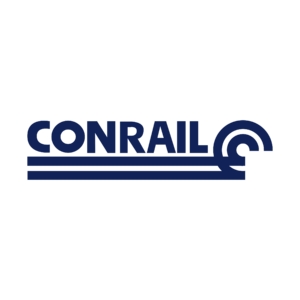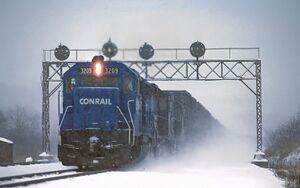Consolidated Rail Corporation: Difference between revisions
No edit summary |
No edit summary |
||
| Line 4: | Line 4: | ||
[[File:Conrail logo.png|frameless|right|Conrail logo]] | [[File:Conrail logo.png|frameless|right|Conrail logo]] | ||
[[File:CR3209.jpg|frameless|right|Conrail GP40]] | |||
== History == | == History == | ||
Revision as of 00:30, 17 December 2023
Conrail (reporting mark CR), also known as the Consolidated Rail Corporation is the primary Class I railroad in the Northeastern and Northern United States formed in 1976. The trade name Conrail is a portmanteau based on the company's legal name. The federal government created Conrail to take over the potentially-profitable lines of multiple bankrupt carriers, including the Penn Central Transportation Company and Erie Lackawanna Railway. After railroad regulations were lifted by the 4R Act and the Staggers Act, Conrail began to turn a profit in the 1980s allowing for much needed infrastructure and equipment upgrades.
History
Context: 1973-1976
In the years leading to 1973, the freight railroad system of the United States was collapsing. Although government-funded Amtrak took over intercity passenger services on May 1, 1971, railroad companies continued to lose money due to extensive government regulations, expensive labor costs, competition from other transportation modes, declining industrial business and other factors.
Its largest Eastern railroad, the Penn Central Railroad (PC), had declared bankruptcy in 1970, after less than three years of existence. Formed in 1968 by the merger of the New York Central Railroad and Pennsylvania Railroad (and supplemented in 1969 by the New York, New Haven and Hartford Railroad), the PC was created with almost no plans to merge the varied corporate cultures, and the resulting company was a hopelessly-entangled mess. At its lowest point, PC was losing over $1 million a day and trains were becoming lost all over the railroad.
In 1972, Hurricane Agnes damaged the rundown Northeast railway network and threatened the solvency of other railroads, including the somewhat more solvent Erie Lackawanna (EL). In mid-1973, officials with the bankrupt Penn Central threatened to liquidate and cease operations by year's end if they did not receive government aid by October 1. This threat to US freight and passenger traffic galvanized Congress to quickly create a bill to nationalize the bankrupt railroads. The Association of American Railroads, which opposed nationalization, submitted an alternate proposal for a government-funded private company. Judge Fullam forced the Penn Central to operate into 1974, when, on January 2, after threatening a veto, President Richard Nixon signed the Regional Rail Reorganization Act of 1973 into law. The "3R Act," as it was called, provided interim funding to the bankrupt railroads and defined a new Consolidated Rail Corporation under the Association of American Railroads' plan.
The 3R Act also formed the United States Railway Association (USRA), another government corporation, taking over the powers of the Interstate Commerce Commission with respect to allowing the bankrupt railroads to abandon unprofitable lines. The USRA was incorporated on February 1, 1974, and Edward G. Jordan, an insurance executive from Nevada, was named president on March 18 by Nixon. Arthur D. Lewis of Eastern Air Lines was appointed chairman on April 30, and the remainder of the board was named on May 30 and sworn in on July 11. Under the 3R Act, the USRA was to create a "Final System Plan" to decide which lines should be included in the new Consolidated Rail Corporation. Unlike most railroad consolidations, only the designated lines were to be taken over. During a review of the plan, it was concluded that too many lines were being left abandoned. The USRA would add that those lines were to be reactivated once the railroad is financially stable. Other lines would be sold to Amtrak, various state governments, transportation agencies, and solvent railroads. The plan was unveiled on July 26, 1975, consisting of lines from Penn Central and six other companies—the Ann Arbor Railroad (bankrupt 1973), Erie Lackawanna Railway (1972), Lehigh Valley Railroad (1970), Reading Company (1971), Central Railroad of New Jersey (1967) and Lehigh and Hudson River Railway (1972). Controlled railroads and jointly-owned railroads such as Pennsylvania-Reading Seashore Lines and the Raritan River Railroad (1980) were also included. It was approved by Congress on November 9, and on February 5, 1976, President Gerald Ford signed the Railroad Revitalization and Regulatory Reform Act of 1976, which included this Final System Plan, into law.
The EL had been formed in 1960 as a merger of the Erie Railroad and Delaware, Lackawanna and Western Railroad. It too was bankrupt, but was somewhat stronger financially than the others. It was ruled reorganized under Chapter 77 on April 30, 1974 (as had the Boston and Maine Railroad), but on January 9, 1975, with no end to its losses in sight, its trustees reconsidered and asked for inclusion. The Final System Plan assigned a major section of the EL, from northern New Jersey west to northeast Ohio, to be sold to the Chessie System, which would help spur competition in Conrail's territory. Chessie, however, could not reach an agreement with EL labor unions, and in February 1976 announced that it would not be buying the EL section. The USRA hurriedly assigned large amounts of trackage rights to the Delaware and Hudson Railway, allowing it to compete in the Philadelphia, Pennsylvania, and Washington, D.C., markets.
Operation: 1976-1982
Conrail was incorporated in Pennsylvania on October 25, 1974, and operations began on April 1, 1976. The government owned 85%, with employees owning the remaining 15%. The theory was that if the service was improved through increased capital investment, the economic basis of the railroad would be improved. During its first seven years, Conrail proved to be highly unprofitable, despite receiving billions of dollars of assistance from Congress. The corporation declared enormous losses on its federal income tax returns from 1976 through 1982, resulting in an accumulated net operating loss of $2.2 billion during that period.
Passenger rail operations
Conrail inherited the commuter rail operations of its predecessor lines. It relinquished several during the 1970s, including the Erie Cleveland–Youngstown service (discontinued in 1977) and the Pennsylvania Railroad Chicago–Valparaiso service (transferred to Amtrak in 1979).
Merger with N&W and SOU
In response to the creation of the Chesapeake, Ohio, & Seaboard railway (CO&S) in November 1980, the Southern Railway and Norfolk and Western Railway intended to merge to create the Norfolk Southern railway, however this proposal was blocked by the ICC. It was suggested for the two profitable railroads to become a part of Conrail to help with its financial state. In 1982, the Norfolk & Western and the Southern railways were merged with Conrail, adding over 8,000 miles of trackage to the system. The N&W’s coal routes greatly improved Conrail’s financial state, and the company started turning a profit in 1983-84.

